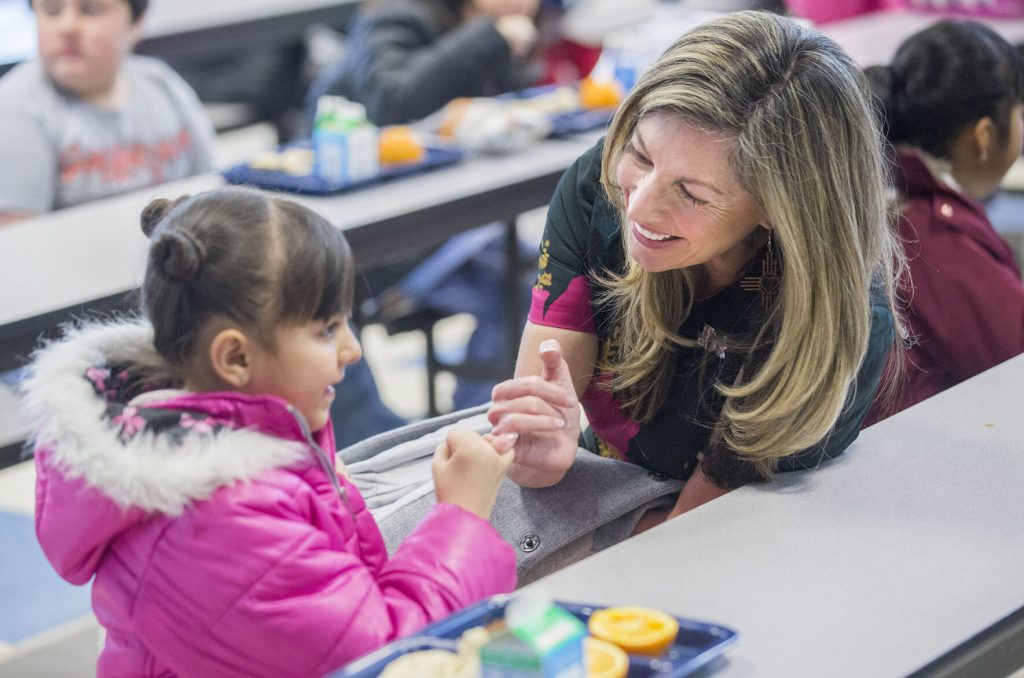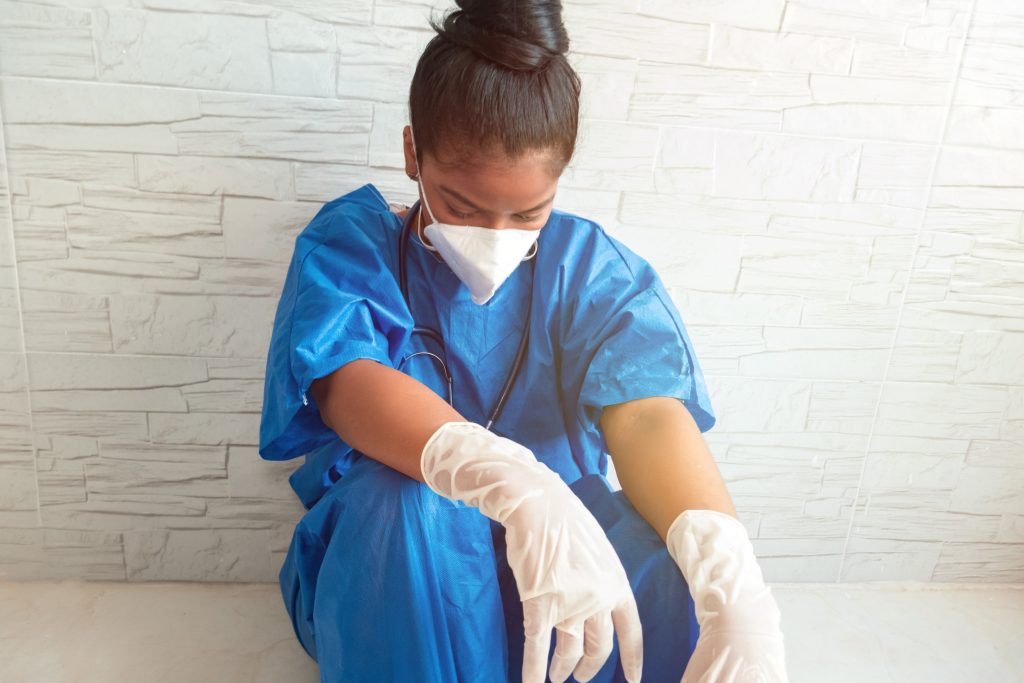During the first twelve months of the COVID-19 pandemic, the academic school year was like no other.
From March 2020 until April 2021, students in New Mexico public schools learned either remotely or through a hybrid model that included some in-person learning. Remote learning nationwide, on average, put more stress on women than men. According to a Marketplace-Edison Research Poll taken last fall of 1,647 individuals, 63 percent of the women polled said they were primarily responsible for helping kids with online school, compared to 29 percent of men. Several women told NM Political Report last year that they struggled with juggling their children’s online learning needs and the demands of their jobs.
Related: Tough on moms: Stories of struggle and juggling demands during the pandemic
In addition, the Legislative Finance Committee produced a report last year that stated that due to the unavoidable closing of in-person learning in March of 2020 until the end of the school year due to the pandemic, some students could fall as much as a year behind in learning.
It also stated that Black, Hispanic and low-income students would be hit the hardest by learning losses.
Another major change to the school year were the ways students are assessed. The New Mexico Public Education Department sought and received an accountability waiver from the U.S. Department of Education for student assessment in February so that no student, school or district would be graded, rated or ranked based on this year’s test scores.
Students who returned to in-person learning in April were encouraged, but not required, to take standardized tests. Students who continued remote learning were tested through local or state-devised assessment systems, according to a statement from PED.
After such a disruptive year, PED said it is “hopeful” that for the 2021-2022 school year, students will return to in-person learning. But the agency is still in a wait-and-see mode due to the virus.
“The status of the pandemic and child vaccinations and the governing public health order at that time will determine the degree of full school reentry in the fall. As always, PED will follow the latest guidance of our state and federal medical experts,” Judy Gibbs Robinson, deputy communications director for PED, wrote in an email.
She said that, currently, the PED’s current mandate allows for online learning as an option in the upcoming school year.
“However, PED is working with districts and schools to expand online learning options for students in the fall,” she wrote.
Learning Loss
Since the pandemic began last year, many have spoken about the lost learning, nationwide, that school children experienced as a result. But, not everyone agrees with the concept.
Mary Parr-Sanchez, president of National Educators Association-NM, said there is another way to think about it.
“I think just framing it as ‘learning loss,’ that we’re already framing it in a deficient lens and looking at students as if they are broken,” she told NM Political Report.
Parr-Sanchez said students were learning during the nearly full year of remote learning but what they learned may not have been academic.
Steve Sianez, government relations for NEA-NM, agreed and told NM Political Report that the technical skills students learned over the past year of school are important.
“To have a skill to function and be able to operate a laptop, tablet, knowing how to connect that device, we speak of it as easy. It’s something I grew up with but ask someone older than me, they struggle with technology and you hear this often,” he said.
He told NM Political Report that measuring loss is difficult to measure.
“I haven’t seen a way to go about measuring loss,” Sianez said. “Teachers adapt to online learning and, in that process, there has to be learning.”
Larry Ferlazzo, a California educator who has written or edited 12 books on education, told NM Political Report that teachers know their students may have missed academic content.
“But they learned resiliency, more responsibility, they had to take care of their siblings or work, they learned tech skills, those are all important equally to knowing when the dates of the American Revolution happened,” Ferlazzo said. “The media is awash in the ‘lost year.’ It isn’t. I don’t think our students feel they’ve wasted a year.”
Parr-Sanchez said talking about ‘learning loss’ doesn’t do well by the students.
“Kids that struggle in New Mexico are not the minority, they are the kids in New Mexico classrooms, so our successful recovery and long-term improvement is recognition that a majority of our kids face barriers to school success from poverty and systemic racism,” she said.
The PED announced its strategy last year and updated this year, to address the loss of academic content. PED is focusing on what it calls accelerated learning. A key component to that is for teachers to assume that all students can engage in grade-level content.
Trying to remediate is ineffectual, according to the PED’s statement.
“This approach of ‘meeting students where they are,’ though well intentioned, practically guarantees students will lose more academic ground and reinforces misguided beliefs that some students cannot do grade-level work,” the statement says.
For students who disengaged in the initial months of remote learning in the spring of 2020, PED partnered with an organization called Graduation Alliance whose role was to “identify, contact and re-engage with students who were disengaged or chronically absent, academically at-risk, or in foster care or homeless, or whose families requested additional support.”
But some in the education community believe in a different learning model altogether called community schools.
Community schools
Dave Greenberg, executive director for Center for Community Schools, NEA-NM, said community schools “rose to the challenge” of providing child care, clothing distributions and nutrition and physical health during the COVID-19 pandemic even as public schools shifted to remote and hybrid learning for close to a year.
The pandemic laid bare racial and economic inequities but the concept of community schools, where the local community has more control over the children’s education “is rooted in a decolonizing approach to education,” he said.
“[It] allows communities to have autonomy over what their education looks like and feels like. That is a racial justice movement. That helps to redress some of the long history of colonization,” Greenberg said.
Community schools are not a new concept nor are they specific to New Mexico, Greenberg said. He said the community school model began with Chicago-based progressive social reformer Jane Addams in the early 1900s.
Greenberg said there are 80 community schools in New Mexico, which makes up about 10 percent of the overall public school system in the state. He said the state currently allocates $5 million to fund community schools. He said there are community schools in New Mexico’s cities, such as Las Cruces where he is based, as well as in smaller communities such as Truth or Consequences.
“Theorists had this conception that schools should be social centers, that they are not simply there to deliver a very traditional core curriculum during the day but that they are ongoing centers that serve as a hub of community and bring people of all ages together for social intercourse,” Greenberg said.
Par-Sanchez said community schools give students “a voice.”
“In middle and high school, there’s no reason why we shouldn’t ask the kids about their own learning and adults guide them but kids [in community schools] have a voice and a say in that. It increases engagement. If we included our communities in our schools, there’d be more of a dialogue between the community that surrounds the school,” she said.
Greenberg said oftentimes, broad-based curriculum is not relevant to the students.
“Community schools provide an opportunity for the whole system to be more responsive to diverse communities’ needs and cultures,” Greenberg said. “Community schools often have school councils where the family is at the table helping to make decisions and have representation they haven’t had in the past, especially in marginalized communities.”
The future
Although the U.S. Department of Education waived standardized testing assessments for New Mexico as a requirement for the 2020-2021 school year, standardized testing isn’t expected to end with the pandemic even though many educators say it is not the best way to assess student progress.
Ferlazzo said there has been “lots of research that has shown so many different things can affect a students’ response on a standardized test, even the weather and the time of day it’s done.”
“Standardized tests have their place but they have to be kept in their place,” he said.
Parr-Sanchez said the standardized test used to have questions about a sailing regatta.
“Just the geography from where they live can put them at a disadvantage. It’s not an accurate representation of what a kid really does know,” she said.




















